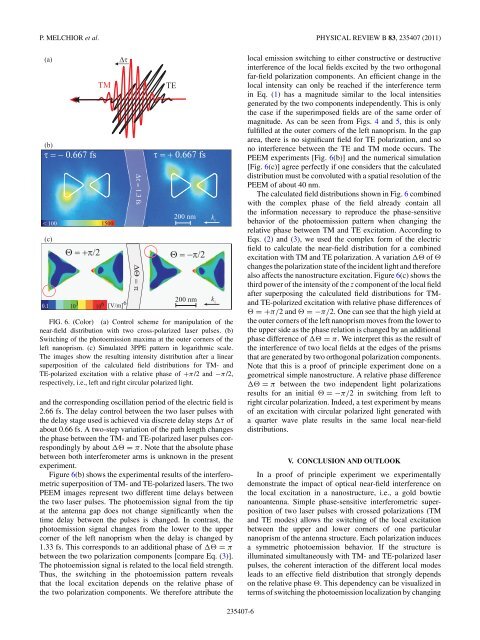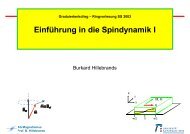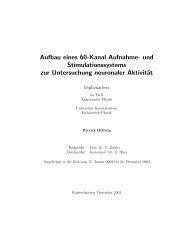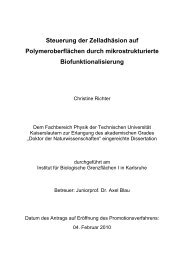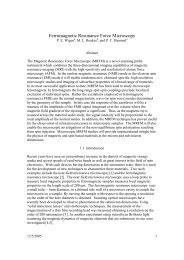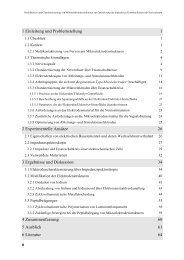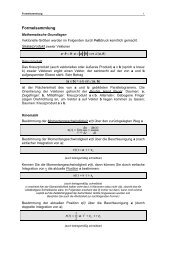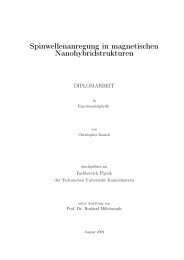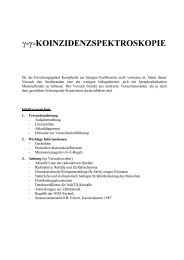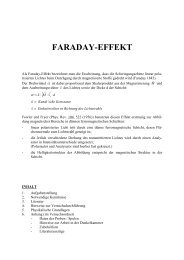Optical near-field interference in the excitation of a bowtie ...
Optical near-field interference in the excitation of a bowtie ...
Optical near-field interference in the excitation of a bowtie ...
You also want an ePaper? Increase the reach of your titles
YUMPU automatically turns print PDFs into web optimized ePapers that Google loves.
P. MELCHIOR et al. PHYSICAL REVIEW B 83, 235407 (2011)<br />
(a)<br />
(b)<br />
< 100<br />
(c)<br />
0.1<br />
10 3<br />
fs<br />
TM<br />
10 6<br />
1500<br />
[V/m] 6<br />
fs<br />
TE<br />
fs<br />
200 nm k ||<br />
200 nm k ||<br />
FIG. 6. (Color) (a) Control scheme for manipulation <strong>of</strong> <strong>the</strong><br />
<strong>near</strong>-<strong>field</strong> distribution with two cross-polarized laser pulses. (b)<br />
Switch<strong>in</strong>g <strong>of</strong> <strong>the</strong> photoemission maxima at <strong>the</strong> outer corners <strong>of</strong> <strong>the</strong><br />
left nanoprism. (c) Simulated 3PPE pattern <strong>in</strong> logarithmic scale.<br />
The images show <strong>the</strong> result<strong>in</strong>g <strong>in</strong>tensity distribution after a li<strong>near</strong><br />
superposition <strong>of</strong> <strong>the</strong> calculated <strong>field</strong> distributions for TM- and<br />
TE-polarized <strong>excitation</strong> with a relative phase <strong>of</strong> +π/2 and −π/2,<br />
respectively, i.e., left and right circular polarized light.<br />
and <strong>the</strong> correspond<strong>in</strong>g oscillation period <strong>of</strong> <strong>the</strong> electric <strong>field</strong> is<br />
2.66 fs. The delay control between <strong>the</strong> two laser pulses with<br />
<strong>the</strong> delay stage used is achieved via discrete delay steps τ <strong>of</strong><br />
about 0.66 fs. A two-step variation <strong>of</strong> <strong>the</strong> path length changes<br />
<strong>the</strong> phase between <strong>the</strong> TM- and TE-polarized laser pulses correspond<strong>in</strong>gly<br />
by about = π. Note that <strong>the</strong> absolute phase<br />
between both <strong>in</strong>terferometer arms is unknown <strong>in</strong> <strong>the</strong> present<br />
experiment.<br />
Figure 6(b) shows <strong>the</strong> experimental results <strong>of</strong> <strong>the</strong> <strong>in</strong>terferometric<br />
superposition <strong>of</strong> TM- and TE-polarized lasers. The two<br />
PEEM images represent two different time delays between<br />
<strong>the</strong> two laser pulses. The photoemission signal from <strong>the</strong> tip<br />
at <strong>the</strong> antenna gap does not change significantly when <strong>the</strong><br />
time delay between <strong>the</strong> pulses is changed. In contrast, <strong>the</strong><br />
photoemission signal changes from <strong>the</strong> lower to <strong>the</strong> upper<br />
corner <strong>of</strong> <strong>the</strong> left nanoprism when <strong>the</strong> delay is changed by<br />
1.33 fs. This corresponds to an additional phase <strong>of</strong> = π<br />
between <strong>the</strong> two polarization components [compare Eq. (3)].<br />
The photoemission signal is related to <strong>the</strong> local <strong>field</strong> strength.<br />
Thus, <strong>the</strong> switch<strong>in</strong>g <strong>in</strong> <strong>the</strong> photoemission pattern reveals<br />
that <strong>the</strong> local <strong>excitation</strong> depends on <strong>the</strong> relative phase <strong>of</strong><br />
<strong>the</strong> two polarization components. We <strong>the</strong>refore attribute <strong>the</strong><br />
local emission switch<strong>in</strong>g to ei<strong>the</strong>r constructive or destructive<br />
<strong><strong>in</strong>terference</strong> <strong>of</strong> <strong>the</strong> local <strong>field</strong>s excited by <strong>the</strong> two orthogonal<br />
far-<strong>field</strong> polarization components. An efficient change <strong>in</strong> <strong>the</strong><br />
local <strong>in</strong>tensity can only be reached if <strong>the</strong> <strong><strong>in</strong>terference</strong> term<br />
<strong>in</strong> Eq. (1) has a magnitude similar to <strong>the</strong> local <strong>in</strong>tensities<br />
generated by <strong>the</strong> two components <strong>in</strong>dependently. This is only<br />
<strong>the</strong> case if <strong>the</strong> superimposed <strong>field</strong>s are <strong>of</strong> <strong>the</strong> same order <strong>of</strong><br />
magnitude. As can be seen from Figs. 4 and 5, this is only<br />
fulfilled at <strong>the</strong> outer corners <strong>of</strong> <strong>the</strong> left nanoprism. In <strong>the</strong> gap<br />
area, <strong>the</strong>re is no significant <strong>field</strong> for TE polarization, and so<br />
no <strong><strong>in</strong>terference</strong> between <strong>the</strong> TE and TM mode occurs. The<br />
PEEM experiments [Fig. 6(b)] and <strong>the</strong> numerical simulation<br />
[Fig. 6(c)] agree perfectly if one considers that <strong>the</strong> calculated<br />
distribution must be convoluted with a spatial resolution <strong>of</strong> <strong>the</strong><br />
PEEM <strong>of</strong> about 40 nm.<br />
The calculated <strong>field</strong> distributions shown <strong>in</strong> Fig. 6 comb<strong>in</strong>ed<br />
with <strong>the</strong> complex phase <strong>of</strong> <strong>the</strong> <strong>field</strong> already conta<strong>in</strong> all<br />
<strong>the</strong> <strong>in</strong>formation necessary to reproduce <strong>the</strong> phase-sensitive<br />
behavior <strong>of</strong> <strong>the</strong> photoemission pattern when chang<strong>in</strong>g <strong>the</strong><br />
relative phase between TM and TE <strong>excitation</strong>. Accord<strong>in</strong>g to<br />
Eqs. (2) and (3), we used <strong>the</strong> complex form <strong>of</strong> <strong>the</strong> electric<br />
<strong>field</strong> to calculate <strong>the</strong> <strong>near</strong>-<strong>field</strong> distribution for a comb<strong>in</strong>ed<br />
<strong>excitation</strong> with TM and TE polarization. A variation <strong>of</strong> <br />
changes <strong>the</strong> polarization state <strong>of</strong> <strong>the</strong> <strong>in</strong>cident light and <strong>the</strong>refore<br />
also affects <strong>the</strong> nanostructure <strong>excitation</strong>. Figure 6(c) shows <strong>the</strong><br />
third power <strong>of</strong> <strong>the</strong> <strong>in</strong>tensity <strong>of</strong> <strong>the</strong> z component <strong>of</strong> <strong>the</strong> local <strong>field</strong><br />
after superpos<strong>in</strong>g <strong>the</strong> calculated <strong>field</strong> distributions for TMand<br />
TE-polarized <strong>excitation</strong> with relative phase differences <strong>of</strong><br />
=+π/2 and =−π/2. One can see that <strong>the</strong> high yield at<br />
<strong>the</strong> outer corners <strong>of</strong> <strong>the</strong> left nanoprism moves from <strong>the</strong> lower to<br />
<strong>the</strong> upper side as <strong>the</strong> phase relation is changed by an additional<br />
phase difference <strong>of</strong> = π. We <strong>in</strong>terpret this as <strong>the</strong> result <strong>of</strong><br />
<strong>the</strong> <strong><strong>in</strong>terference</strong> <strong>of</strong> two local <strong>field</strong>s at <strong>the</strong> edges <strong>of</strong> <strong>the</strong> prisms<br />
that are generated by two orthogonal polarization components.<br />
Note that this is a pro<strong>of</strong> <strong>of</strong> pr<strong>in</strong>ciple experiment done on a<br />
geometrical simple nanostructure. A relative phase difference<br />
= π between <strong>the</strong> two <strong>in</strong>dependent light polarizations<br />
results for an <strong>in</strong>itial =−π/2 <strong>in</strong> switch<strong>in</strong>g from left to<br />
right circular polarization. Indeed, a test experiment by means<br />
<strong>of</strong> an <strong>excitation</strong> with circular polarized light generated with<br />
a quarter wave plate results <strong>in</strong> <strong>the</strong> same local <strong>near</strong>-<strong>field</strong><br />
distributions.<br />
V. CONCLUSION AND OUTLOOK<br />
In a pro<strong>of</strong> <strong>of</strong> pr<strong>in</strong>ciple experiment we experimentally<br />
demonstrate <strong>the</strong> impact <strong>of</strong> optical <strong>near</strong>-<strong>field</strong> <strong><strong>in</strong>terference</strong> on<br />
<strong>the</strong> local <strong>excitation</strong> <strong>in</strong> a nanostructure, i.e., a gold <strong>bowtie</strong><br />
nanoantenna. Simple phase-sensitive <strong>in</strong>terferometric superposition<br />
<strong>of</strong> two laser pulses with crossed polarizations (TM<br />
and TE modes) allows <strong>the</strong> switch<strong>in</strong>g <strong>of</strong> <strong>the</strong> local <strong>excitation</strong><br />
between <strong>the</strong> upper and lower corners <strong>of</strong> one particular<br />
nanoprism <strong>of</strong> <strong>the</strong> antenna structure. Each polarization <strong>in</strong>duces<br />
a symmetric photoemission behavior. If <strong>the</strong> structure is<br />
illum<strong>in</strong>ated simultaneously with TM- and TE-polarized laser<br />
pulses, <strong>the</strong> coherent <strong>in</strong>teraction <strong>of</strong> <strong>the</strong> different local modes<br />
leads to an effective <strong>field</strong> distribution that strongly depends<br />
on <strong>the</strong> relative phase . This dependency can be visualized <strong>in</strong><br />
terms <strong>of</strong> switch<strong>in</strong>g <strong>the</strong> photoemission localization by chang<strong>in</strong>g<br />
235407-6


